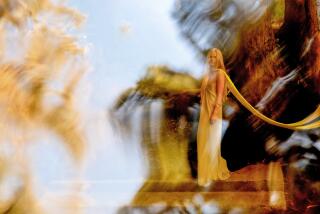A Path With Some Typical New Age Pitfalls
- Share via
In the summer of 1987, I was on an airplane from New Delhi to Paris. I had just spent two months in India, and my head was in a state of perpetual spin. I had brought a journal with me, but I hadn’t been able to write anything. The man sitting next to me for the flight was a quiet, sweet man, who drew me into a conversation, and I confessed my dismay about not being able to keep the journal.
“But of course you can’t write about India while you’re there,” he said playfully. “It’s like writing about a dream while you’re having it.” I smiled and asked his name. “Andrew,” he said, “Andrew Harvey.”
Over the years, Andrew Harvey’s stature as a teacher and writer has grown. He has written about the Buddhist temples of Ladakh and about the Tibetan philosophies of life and death, and now he offers a book that attempts to distill what he has learned after two decades of searching: “The Direct Path is the Path to God without dogma or priests or gurus, the Path of direct self-empowerment and self-awakening in and under God in the heart of life. . . . Whether you yet know it or not, you have been on this path since the day you were born.”
In the panoply of nontraditional teachers, Harvey has an unusual pedigree. He was the youngest person ever elected to Oxford’s All Souls College, which is sort of a think tank for academic superstars. He was a voracious reader and an avid student. “The Direct Path” reflects his erudition in the way that it assembles a wide range of teachings scattered throughout the world’s great religious traditions. One moment Harvey is quoting from India’s Sri Aurobindo or Ramakrishna, the next from the great Sufi mystic Rumi, and then from the Cabala, Native American healers and St. Francis. “The Direct Path” is a feast of the great religious teachings of the world.
Much of the book consists of exercises that Harvey has assembled over the years and which he himself evidently practices. The goal is nothing less than the birth of a “new humanity,” which will be the product of “direct and unmediated contact with the Divine.” The exercises are ways to work through all the fear, confusion and pain that keep us removed from God and from one another. For the most part, they entail different forms of meditation and yoga, and Harvey writes about each in loving detail. He also has chapters on diet and health, and on sex and Tantrism.
Year by year, Harvey has become less interested in what people outside those frameworks think of his work and his teachings. This book is by far the most “New Agey” of anything he has written and, unfortunately, it has all the weaknesses of the genre. The language is often simplistic and vague, not in the positive sense of a Zen koan but in the syrupy sense of an ashram refugee.
Harvey is at his most acute when he discusses his own journey and his struggles on it. When recounting his disillusionment with his former teacher Mother Meera and her vitriolic homophobia when he announced that he was going to marry the man he now lives with, he conveys the depth of doubt and suffering that accompanies all of us. When, however, he describes the exercises in over a hundred pages of prose, he is indistinguishable from dozens of other New Age teachers who hold out the promise of enlightenment in 10 (or in Harvey’s case, 18) easy steps.
On the one hand, Harvey appears like a man who wishes to share what he has learned, and in that vein, he is humble, touching and even wise. Yet, the other guise, Harvey the inadvertent guru, gets in the way. He doesn’t seem to yearn for gurudom, yet the very presentation of the exercises suggests that he sees himself as a spiritual teacher rooted in the mystic traditions of the East, Christianity and Islam. And here, he has little to add except a unique ability to synthesize the teachings of others.
Furthermore, it’s a testament to the limitations of the path as defined by Harvey that it is almost entirely devoid of other people. Only in the chapter on sex does he discuss the spiritual dimensions of relationships with other people. The rest involves only the individual in struggle with and communion with his or her own soul and God. That honors the teachings of when the Buddha walked the Earth, but it doesn’t speak to the vastly different world of personal relationship that characterizes our society. Harvey maps out a solitary path, which may have made sense centuries ago, when romantic love was rare and society was rigidly stratified, but seems anachronistic today. It is a path that may have brought Harvey to a deeper sense of himself and a deeper connection to those he loves, but, as described in these pages, it seems more like a path of loneliness than a direct route to the divine.
*
Zachary Karabell is a contributing writer for Book Review.
More to Read
Sign up for our Book Club newsletter
Get the latest news, events and more from the Los Angeles Times Book Club, and help us get L.A. reading and talking.
You may occasionally receive promotional content from the Los Angeles Times.







